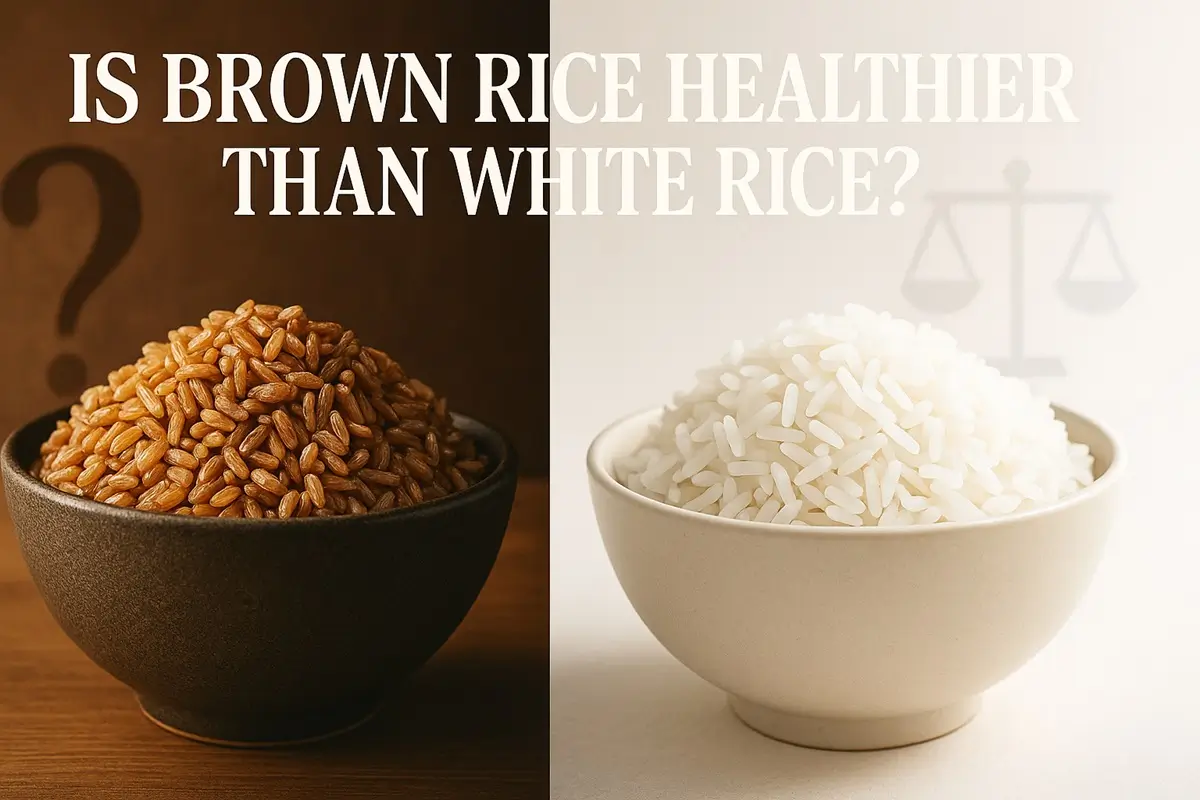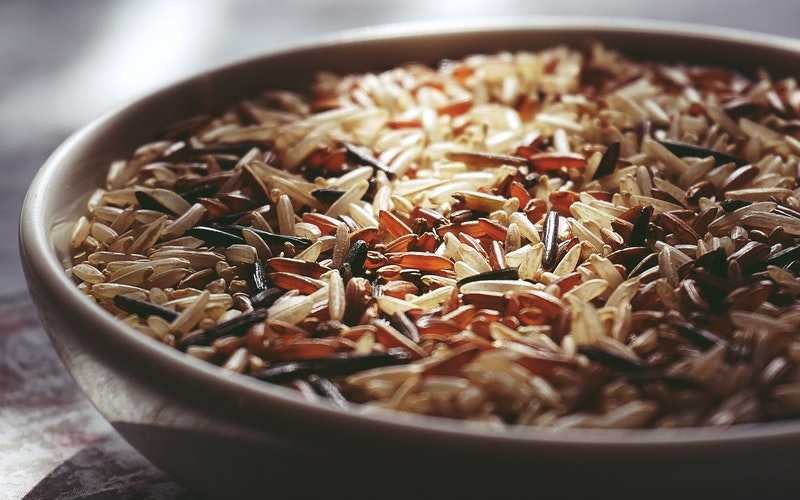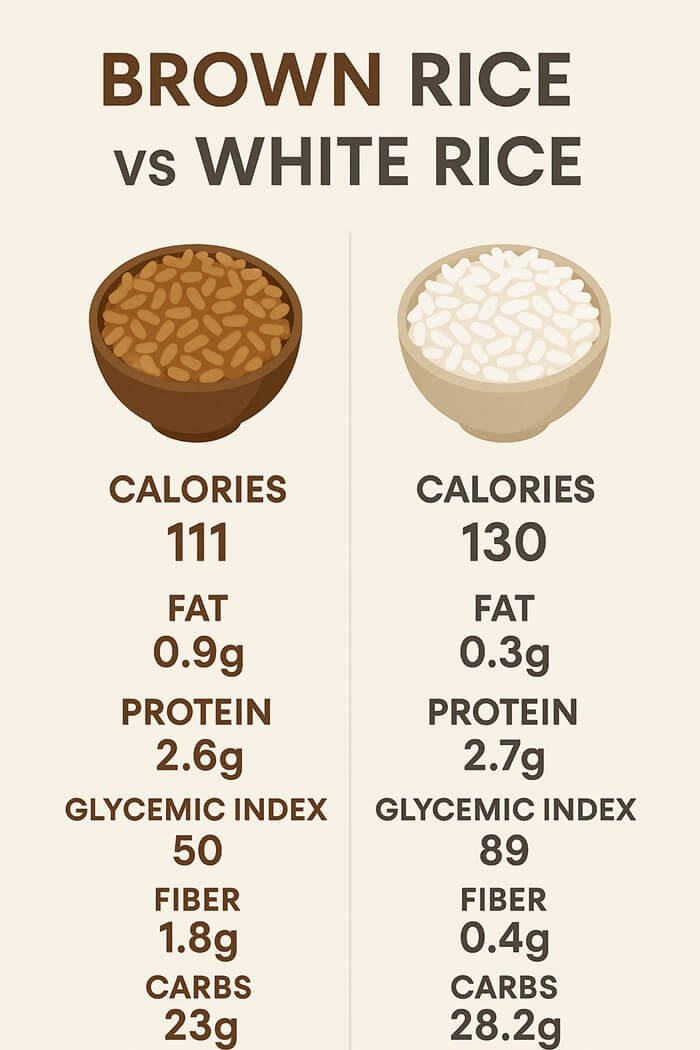Is Brown Rice Healthier Than White Rice?
A nutritional analysis of two grains that reveals surprising trade-offs in fiber, arsenic, and blood sugar control

The difference = processing. Brown rice
The answer isn’t as simple as “brown good, white bad.” Data shows brown rice delivers more nutrients per serving, but it also carries a hidden problem that might surprise you.
Is brown rice healthier than white rice? Both rice types come from the same grain. Both of them are starches, both can be cooked and used in similar dishes. However, we have all heard that brown rice is the best choice among the two for our health.
The main reason brown rice is considered healthier than white rice is because of the processing each type of rice undergoes. Brown rice keeps its fiber-rich outer layers, while white rice gets stripped down to its starchy core [1]. Thus, Brown rice has more fiber and a lower glycemic index. But, usually, brown rice has more arsenic, a substance that poisons the human body.
Although by its very nature brown rice contains more vitamins and minerals than white rice, both have about the same amount of vitamins and minerals when they arrive at our table.
This is due to the fact that white rice is enriched during its refining process. Both brown and white rice, have b vitamins, iron, and zinc.

Brown Rice Vs White Rice Comparison Table
Here’s what 100 grams of cooked rice actually contains:
| Nutrients (100 g) Cooked | Brown Rice | White Rice (Enriched) |
|---|---|---|
| Calories | 111 Kcal | 130 Kcal |
| Fat | 0.9 g | 0.3 g |
| Protein | 2.6 g | 2.7 g |
| Glycemic Index | GI 50 | GI 89 |
| Dietary Fiber | 1.8 g | 0.4 g |
| Carbohydrates | 23.0 g | 28.2 g |
| Total Omega-3 fatty acids | 14.0 mg | 13.0 mg |
| Total Omega-6 fatty acids | 309 mg | 62.0 mg |
| Magnesium | 43.0 mg | 12.0 mg |
| Phosphorus | 83.0 mg | 43.0 mg |
| Potassium | 43.0 mg | 35.0 mg |
| Folate | 4.0 mcg | 58.0 mcg |
Source: USDA FoodData Central [2]
Brown rice packs 4.5 times more fiber and nearly four times the magnesium [3]. But here’s where it gets weird = white rice actually contains more folate due to enrichment programs.
- Protein – When it comes to protein and fat, brown and white rice are similar. Both types of rice are low in fat and contain about 4.5 grams of protein per cooked cup.
- Calories – In terms of calories, brown rice has fewer calories per serving than white rice. Brown rice has about 111 calories per cup, cooked, while white rice has 130 calories. This is a clear advantage of brown rice vs white rice.
- Carbohydrates – Brown rice has slightly fewer carbohydrates so if you are doing Keto or keeping track of your carbs intake, then Brown Rice is more suitable for you.
- Fiber – Each cup of cooked brown rice has significantly more fiber than a cup of cooked white rice. That means that you’ll be able to poop more and make you feel full longer. This helps with weight loss as well.
- Magnesium, Phosphorus, Potassium – Brown rice dominates here. It delivers nearly 4x the magnesium (43mg vs 12mg), double the phosphorus (83mg vs 43mg), and slightly more potassium (43mg vs 35mg). These minerals support muscle function, bone health, and nerve transmission.
- Omega Fatty Acids – Brown rice contains 5x more omega-6 fatty acids (309mg vs 62mg) while omega-3 levels stay similar (14mg vs 13mg). This creates a higher omega-6 ratio, which some nutritionists consider less balanced.
- Folate – White rice wins big here due to enrichment = 58mcg versus brown rice’s measly 4mcg. Pregnant women and those needing folate should note this reversal.
With fewer carbohydrates and calories, more minerals and significantly higher fiber content per serving, brown rice appears to be clearly a healthier option.
The Glycemic Index Gap
Brown rice registers a glycemic index (GI) of 50, while white rice hits 89 [1].
What does this mean for your blood sugar?
Brown rice, which contains more nutrients and fiber and has a lower glycemic index value, is a healthier choice for most people, according to Harvard Health [3].
Foods with lower GI scores cause slower blood sugar spikes. For diabetics and people watching their glucose levels, this matters.
However, you should know that the different varieties of rice differ significantly in the glycemic index, which depends on the type of starch.
The Arsenic Problem Nobody Talks About
Now, here’s the plot twist.. Brown rice contains significantly more arsenic than white rice [4]. Arsenic is a toxic metalloid that occurs naturally in soil and water but becomes dangerous when it accumulates in the human body over time. Inorganic arsenic concentration is 1.5 times higher in brown rice than in white rice [5].
Why? Arsenic concentrates in the outer bran layers that brown rice keeps but white rice discards [4]. The FDA found average arsenic levels of 154 parts per billion in brown rice versus 92 ppb in white rice [5].
“Is this dangerous?” The FDA estimates rice consumption causes four additional cancer cases per 100,000 Americans over a lifetime [6]. That’s less than 1% of total lung and bladder cancers.
Ιf you are looking for an alternative food to rice, you can consume buckwheat, quinoa or brown Bulgur wheat.

Processing Makes the Difference
All rice starts brown. White rice goes through milling that removes the husk, bran, and germ [1]. This process:
- Removes fiber, vitamins, and minerals
- Reduces cooking time
- Extends shelf life
- Strips away natural oils that can go rancid
Food companies then fortify white rice with synthetic vitamins, particularly folate and B vitamins [2].
Which Rice Wins for Weight Management?
Brown rice contains fewer calories per serving = 111 versus 130 calories per 100g cooked [2]. The higher fiber content also means you feel full faster and longer.
But protein content? Nearly identical. Both types deliver about 2.6-2.7 grams per 100g serving [2].
When White Rice Makes Sense
If you’re experiencing a flare-up of a digestive condition that makes it harder to digest fiber, white rice may be a better option [3].
White rice works better for:
- People with inflammatory bowel disease
- Those recovering from digestive surgery
- Athletes needing quick-digesting carbs
- Anyone with fiber sensitivities
Practical Safety Tips for Rice Consumption
The FDA recommends these steps to reduce arsenic exposure [7]:
- Rinse rice before cooking until water runs clear
- Use extra water when cooking (6:1 ratio water to rice)
- Drain excess water after cooking
- Vary your grain choices = don’t eat rice every day
Rice Alternatives Worth Considering
Fed up with the arsenic issue? These grains contain much lower levels:
- Quinoa
- Bulgur wheat
- Barley
- Farro
- Buckwheat
Each provides different nutrient profiles but similar versatility in cooking.
So, Is Brown Rice Healthier Than White Rice?
Brown rice delivers more nutrients and better blood sugar control. White rice offers easier digestion and lower arsenic exposure.
Your best choice depends on your health goals, digestive capacity, and overall diet variety. Neither option is inherently “bad” = both can fit into a balanced eating pattern.
The real question isn’t which rice is healthier. It’s whether rice should dominate your grain intake at all. (Ed. note: Moderation and variety consistently beat any single “superfood” approach.)
Final Analysis: Brown rice wins on most nutrients = more fiber, magnesium, phosphorus, and lower calories. White rice counters with less arsenic, better folate content, and easier digestion. Both provide similar protein levels and cooking versatility. Your choice should match your health priorities, digestive tolerance, and dietary variety goals.
References
[1] Harvard Health – Brown rice versus white rice: A head-to-head comparison – November 8, 2024
[2] USDA FoodData Central – Rice, brown, long-grain, cooked – 2024
[3] Harvard Health – Brown rice versus white rice: A head-to-head comparison – November 8, 2024
[4] Nutrition Daily – White Rice vs Brown Rice Nutrition—the Shocking Truth – February 27, 2024
[5] PMC – Arsenic in brown rice: do the benefits outweigh the risks? – 2023
[6] FDA – FDA proposes limit for inorganic arsenic in infant rice cereal – 2016
[7] FDA – What You Can Do to Limit Exposure to Arsenic – 2024
